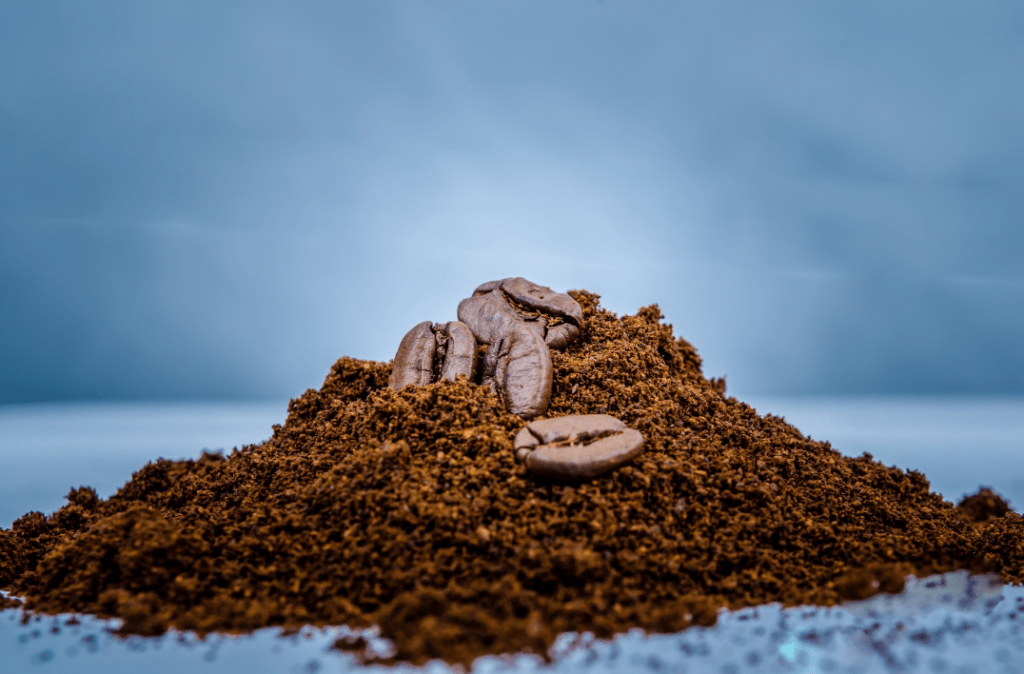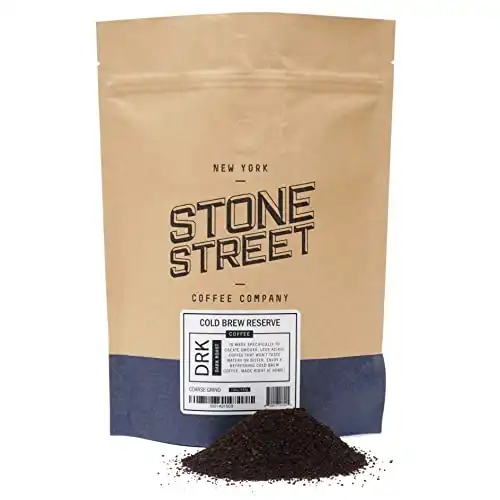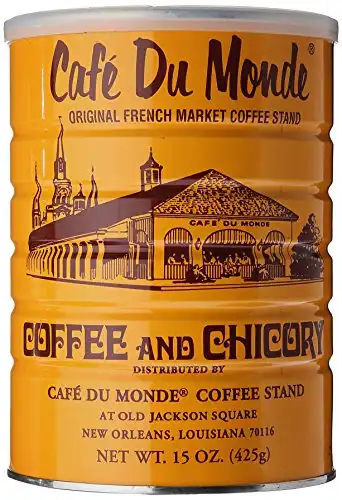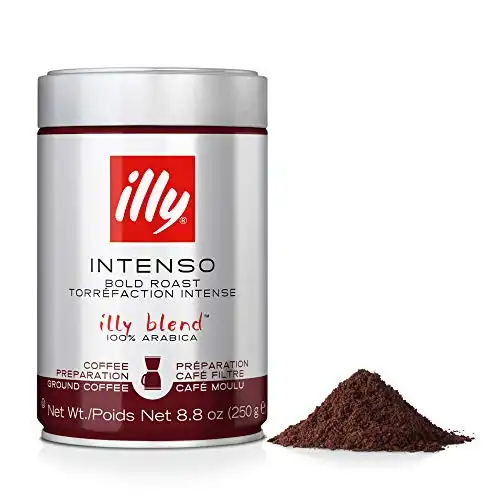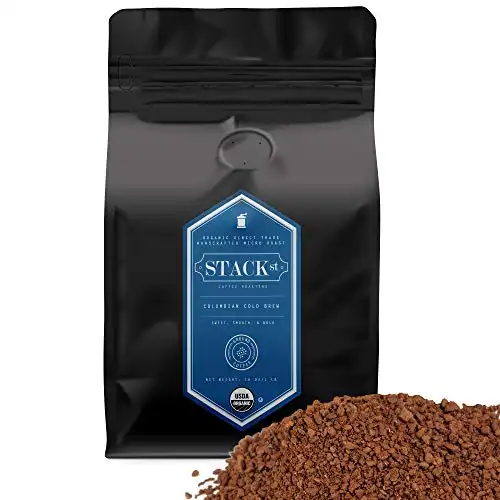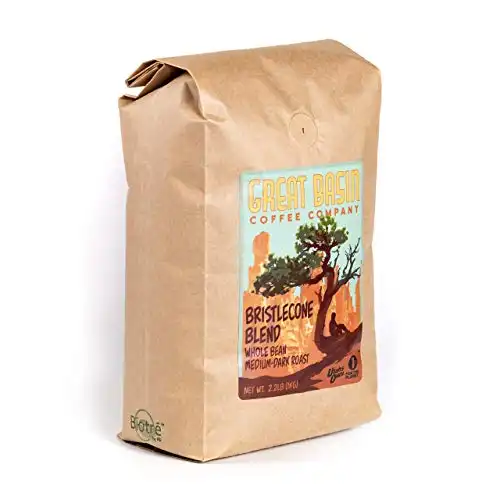- Why Grind Size Matters
- Quick Glance: Best Coarse Ground Coffee
- What is Coarse Ground Used For?
- What Does Coarse Ground Coffee Look Like?
- Grind at Home: How to Achieve a Coarse Grind
- Where to Buy Coarse Ground Coffee
- Frequently Asked Questions
- What is coarse ground coffee used for?
- Is coarse ground coffee the same as ground coffee?
- Is coarse ground coffee stronger?
- What is the ideal grind size for French press?
- What is the right grind size for a pour-over?
- What is the best grind size for Chemex?
- What is the right grind size for a cold brew?
- What is the best grind size for Aeropress?
- Final Word
As a person who has been brewing coffee from home, you’ll agree with me on one thing: coffee isn’t just coffee.
Coffee will taste different depending on the coffee bean, brewing temperature, brewing time, and grind size.
Thus, when considering all of these factors, always keep the grind size in mind.
Generally, coffee grounds have three most common sizes: fine, medium, and coarse.
Our focus will be on coarse ground coffee.
Keep reading to know why you should consider grind size before brewing coffee, what coarse ground coffee to use, suitable brewing methods for it and much more!
Ready? Let’s dive in.
We want you to know this post contains affiliate links. If you click on a product and decide to buy it we may earn a small commission at no extra cost to you.
Why Grind Size Matters
Grind size affects the texture and flavor of your drink. Thus, it can determine whether your coffee drink will be flavorful and delicious or bland and tasteless.
Let’s look at how grind size affects both texture and flavor of coffee.
Texture
If at some point, you tasted a bitter and silty cup of coffee, you probably know that a wrong grind size can hugely impact brewed coffee.
When brewing with a stainless filter like in the case of a French press, espresso maker, or percolator, using extra fine grinds, may make the grounds pass through the filter’s pores and make your coffee drink cloudy, gritty, and over-textured.
Paper and cloth filters have smaller perforations, which makes it difficult for any grinds to move through, even if you use very fine grinds. But you may realize that the brewing process takes much longer than normal.
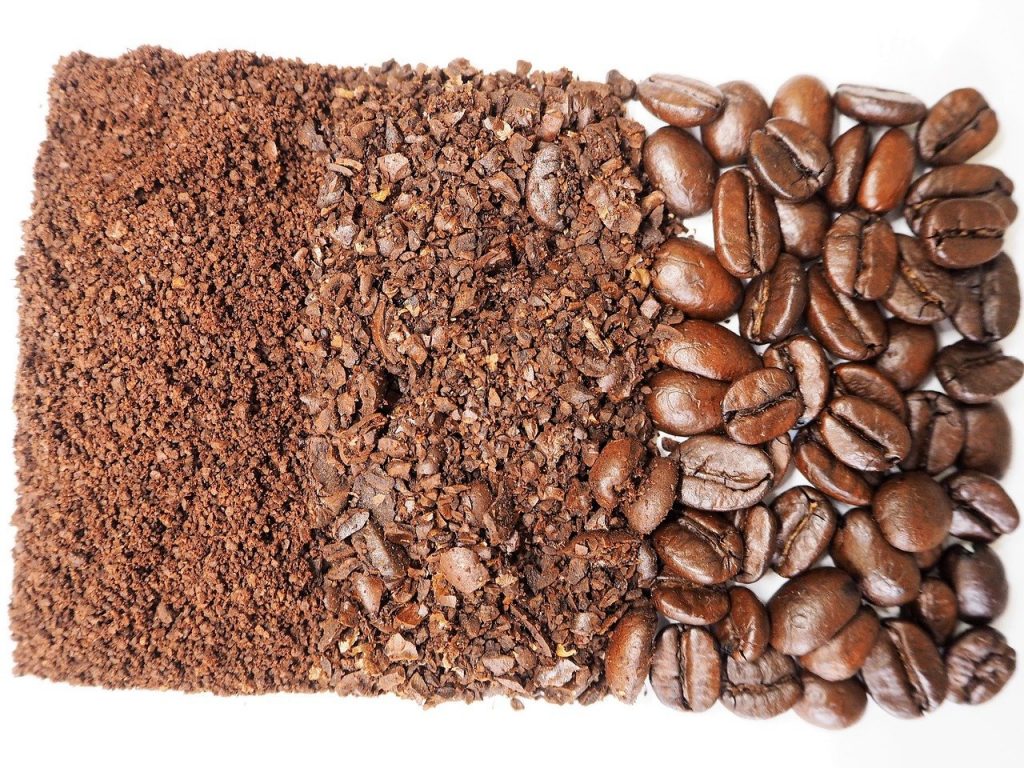
Flavor
To obtain the best flavor from beans, you should extract them effectively. Extraction is the movement of water through the grounds as it picks up the coffee’s unique flavors, oils, and caffeine.
When brewing, the last thing you want is under-extraction or over-extraction. You want the water to flow consistently and evenly over all grounds, instead.
How under-extraction affects flavor
Under-extraction refers to the process where hot water passes through the grounds without picking up enough flavors.
What are the main causes of under-extraction?
The incorrect water temperature or filter can cause this, but the main culprit is coffee grounds that are too coarse.
And how does under-extracted coffee taste?
Its taste is generally weak, bland. But it can also have a slightly sour, acidic, or salty flavor.
How over-extraction affects flavor
Over-extraction is the process where water passes through the grounds and picks up excessive flavor.
The main cause of extraction is using extra fine grounds.
Over-extracted coffee is typically bitter and overly strong, without any complex flavors.
To avoid under-extraction and over-extraction, a coarse grind is usually used for specific brewing methods, including French press, cold brew, and percolator brewing styles (more on that shortly).
How coarseness affects extraction time
The coarseness of coffee refers to the size of its grounds.
A very coarse ground means that coffee has undergone a little grinding, creating large sized coffee grounds.
On the other hand, a very fine ground refers to grinding coffee beans to a gritty powdery texture.
When brewing coarsely ground coffee, hot water surrounds the outside of each grind, absorbing the flavor as it gradually moves to the grind’s center.
Similarly, when brewing finely ground coffee, hot water binds the exterior of each grind. But since the grinds are small-sized, the water moves to the center and extracts the flavor much faster.
In other words, coarse grinds result in a long extraction time and fine grinds result in a short extraction time.
So, why does the coarse grind matter?
Because it has a direct impact on your coffee drink’s flavor.
Particularly, coarse grinds extract slowly, which adds the required flavors, oils, and aroma into your coffee drink.
Quick Glance: Best Coarse Ground Coffee
1. Stone Street Coffee Cold Brew Reserve
2. Café Du Monde Chicory Coffee
3. illy Intenso Ground Drip Coffee
4. Stack Street Organic Cold Brew Coffee
5. Great Basin Coffee Co. Bristlecone Blend
What is Coarse Ground Used For?
As already aforementioned, a coarse grind is ideal for slow extraction. This means any immersion brewing style will work perfectly with a coarse grind.
Thus, any method that requires you to steep the coffee grounds in hot water before filtration is great for coarse grind.
The two methods that work perfectly for this grind type are cold brew and French press.
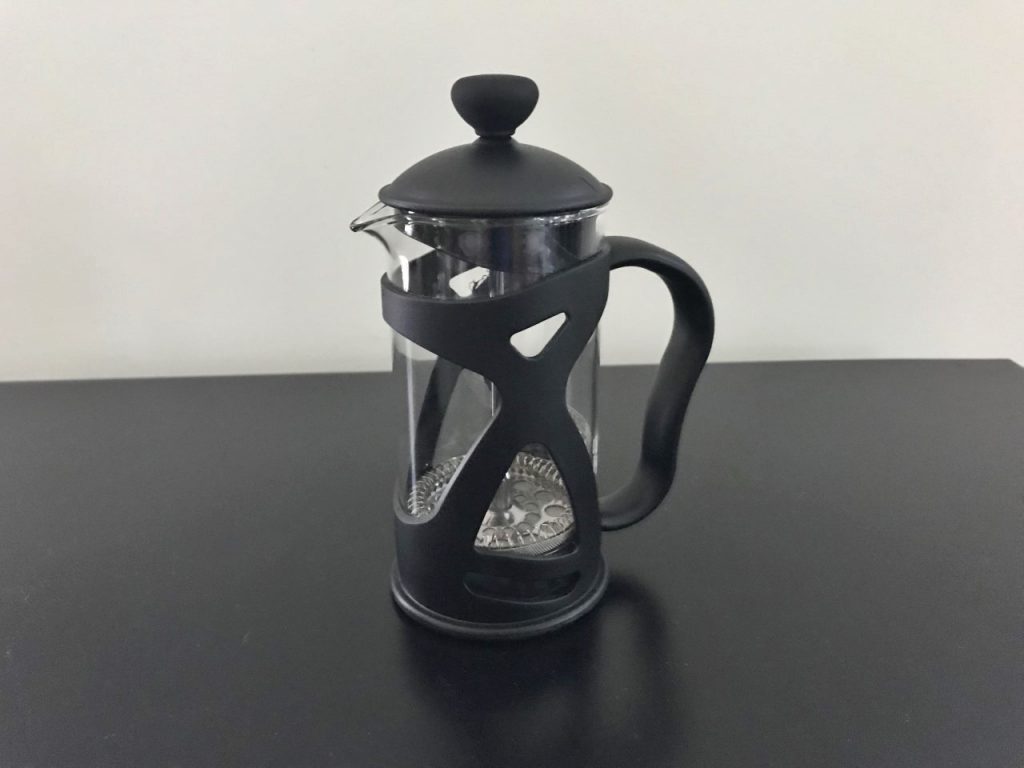
French Press
Here’s a quick refresher of how French press works.
You put coffee grounds in a chamber that resembles a carafe and then pour hot water over them.
Next, you hold on for a couple of minutes for the coffee to bloom.
This is where the grounds steep and produce bubbles, which eliminates carbon dioxide from your coffee, further enhancing its flavor.
You should then place a filter plunger just above the water surface. When you do this, all the coarse grounds move to the chamber’s bottom.
Pushing the plunger to the bottom allows the brew to remain at the top. The next step is to pour the drink in a mug and serve it.
Remember, when using French press to brew coffee, we don’t use a paper filter.
Can that cause a problem?
Yep.
How?
Well, tiny grounds may pass through the permanent filter, making their way right into your cup. And that’s where gritty coffee comes from.
But this problem only arises if you use finer grinds.
Now you know why coarse ground coffee works well with French press.
Let’s move on to the next brew style that uses this type of grind.
Cold Brew
This is another popular immersion style that uses coarse ground coffee.
And the reasons for this are two-fold: The filtration and extended brew time.
How does cold brew style work?
You steep coffee grounds in room temperature or cold water for many hours (often 14 to 20 hours). You can use a French press and other tools to create this brew. The equipment used must be able to hold cold water in a big chamber along with coarsely ground coffee.
After the steeping process, you can employ a wide array of filtration methods, from a single-use paper to reusable fabric.
The steeping process takes many hours, which is why it suits coarse ground coffee.
So, using a finer grind will lead to over-extraction, which will tamper with your coffee flavor.
Percolator
Not many people use a percolator to brew their coffee, but with some know-how and the right technique, percolated coffee can turn out to be way better than what a traditional drip machine makes.
If you enjoy camping or being off the grid and want your coffee with you, percolators will work well for you.
A percolator only requires a stove or hot plate and a basic heating element to function.
How does a percolator work?
To brew coffee with this method, you need to force hot water, either by a pump or boiling action, into a filter basket containing coffee grounds.
It’s best to use coarse grounds as hot water filters through the grounds many times.
Thus, if you use finer grains, the resulting drink will be over-extracted, creating a bitter taste.
Not to mention, you may end up with some grinds in your cup, especially if they are too small to filter out.
What Does Coarse Ground Coffee Look Like?
Whether you’re buying coarse ground coffee from a store or grinding your own from home, how do you know the size you should end up with?
What may look coarse to you might be fine to someone else and vice versa.
So, to clear any doubts, we put down a guide that will make things a lot easier for you during your home coffee grinding sessions.
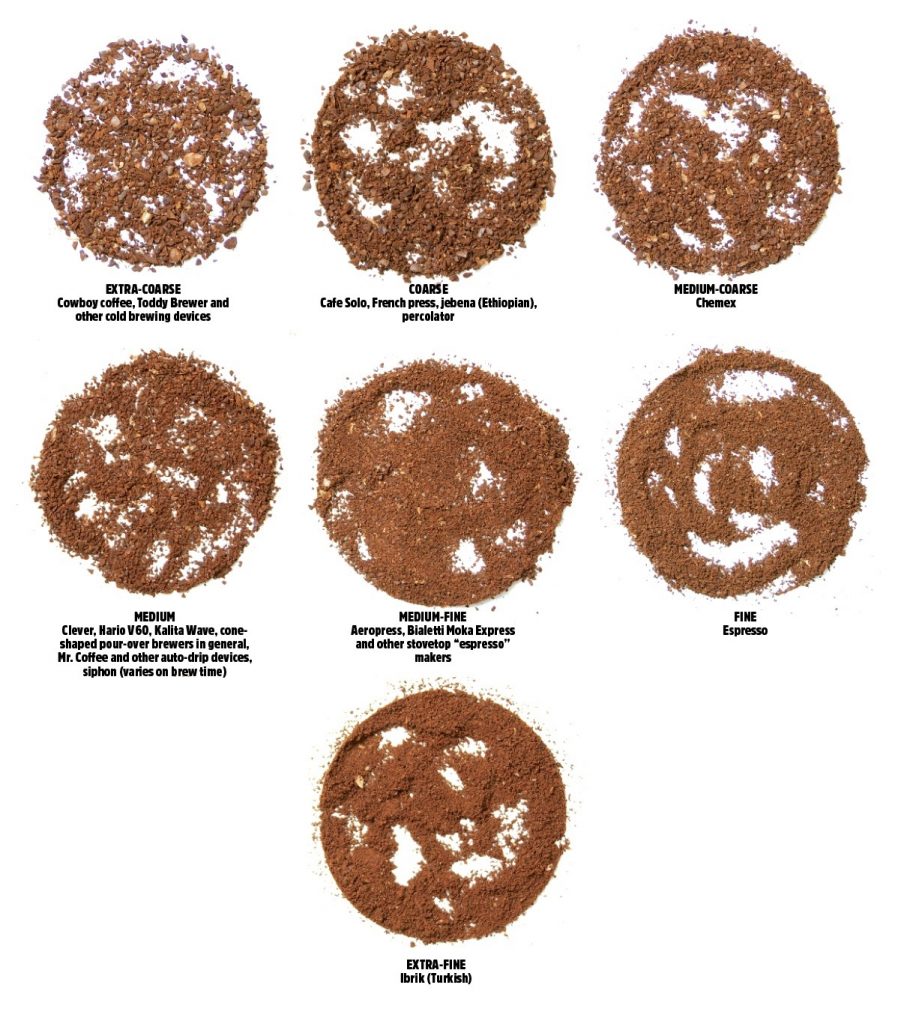
1. Extra Coarse Grind
Extra coarse ground coffee is slightly ground using the biggest burr grinder setting. These grinds have a highly rough texture with big chunks, and the original beans’ shape is still visible.
This grind works perfectly for a cold brew or cowboy-style coffee, which refers to the process of boiling coffee in a pan along with grounds.
2. Coarse Grind
The texture of coarse grinds is similar to that sea salt or kosher. The grounds are large and visibly chunky.
If you prefer making your coffee with French press, percolators or coffee cupping, then you may use this grind type.
3. Medium Coarse
Medium coarse grinds are less chunky with the texture of rough or coarse sand.
The grind works well in specialty coffee makers, such as Chemex.
4. Medium Grind
It’s the most common size for pre-ground beans, and its texture is similar to that of kosher salt or regular/smoother sand.
The grind is ideal for siphon brewers, cone-shaped pour-over brewers, and flat-bottomed drip coffee brewers. Besides, it’s perfect for an Aeropress, especially if you allow it to brew for at least three minutes.
5. Medium-Fine Grind
Are you a fan of pour over coffee?
Then medium fine grounds will work for you.
What do they look like?
Well, they are small granules that are finer than regular sand, but the texture is not as fine as what we use to brew espresso.
Medium fine ground coffee suits cone-shaped pour-over coffee makers, such as Kalita Wave and Hario V60. It also suits the AeroPress (with a brew time of 2 to 3 minutes).
6. Fine Grind
This is also known as the espresso grind.
The granules are too fine and a bit difficult to feel.
Whenever you buy pre-ground coffee, it typically comes as a fine grind size.
Regarding consistency, this grind is a bit finer than table salt.
The fine grind is ideal for espresso brewing and the Aeropress (with a brew time of 1-2 minutes).
7. Extra Fine Grind
You won’t easily use this grind. It has a powdered or flour-like texture.
To create a consistently fine grind like this, you need to use a Turkish coffee grinder.
Among the extra coarse, coarse, and medium-coarse grinds, the latter is the easiest to create with any burr grinder.
On the contrary, the extra coarse grind tends to be inconsistent and can only be achieved with a special grinding equipment.
Here’s an image that summarizes the different grind sizes and where they can be used:
Grind Size | Use |
Extra Coarse | Cold Brew, Cowboy Coffee |
Coarse | French Press, Percolator, Cupping |
Medium Coarse | Chemex, Clever Dripper |
Medium | Pour-over, Auto Drip, Aeropress |
Medium Fine | Pour-over, Aeropress |
Fine | Espresso, Moka Pot, Aeropress |
Extra Fine | Turkish Coffee |
Grind at Home: How to Achieve a Coarse Grind
Some people prefer pre-ground coffee because it saves prep time and is also consistent. But, of course, freshness is not always guaranteed with this type of coffee.
That’s why we always recommend using freshly ground coffee. While it takes some elbow grease, the resulting coffee is flavorsome.
So, how do you achieve a coarse grind at home?
You can use a blade grinder or a burr grinder, but which one should you go with?
Let’s look at what you can do with each.
A Blade Grinder
You can use a blade grinder if you intend to brew coffee with a French press brewer, drip maker, or toddy maker.
Simply put, a blade grinder may be used to make coarse ground coffee. But if you’d like to achieve super-fine grinds for espresso, for instance, these types of grinders won’t work for you.
Blade grinders are inexpensive and easy to use. That’s what makes them popular.
But they have a few drawbacks:
- They can be noisy and messy. Would you prefer a loud sound to awake you or a pleasant coffee aroma?
- A blade grinder pulverizes rather than really grind coffee. This leads to lack of consistency, which means the extraction won’t be complete and smooth.
- Lastly, there’s a learning curve involved.
How to Achieve a Coarse Grind with a Blade Grinder
Typically, a blade grinder features a clear plastic top, covering the coffee bean reservoir.
The blade sits at the reservoir’s center and it resembles (and works) like a propeller.
To use it, pour your beans in the reservoir and put the plastic top.
Next, apply some pressure on the top or press a button (in some cases) to make the blade spin. This pulverizes the coffee beans.
It’s worth noting that blade grinders operate manually, which is why they have no settings.
So, how do you ensure the grinder works to your precision?
Well, you’ll need to combine two things: timing and observation.
But here’s what matters:
The longer you keep grinding, the finer the grounds. In other words, to create coarse grounds, don’t spend a lot of time grinding.
This is much simpler than it sounds.
But wait, there’s more.
Here’s the Secret for Using a Blade Grinder to Achieve Coarse Grinds
First, let’s start with the amount of coffee you need.
Well, for most coffee aficionados, the rule of thumb is 2 tablespoons of beans for every 6 to 8 ounces of water and then adjust it to your taste.
What that simply means is that you use about 2 tablespoons of coffee for every cup.
After loading the grinder, don’t simply put pressure on the button and let it run. Instead, use short bursts (lasting a few seconds each) to keep the coffee from overheating.
During bursts, hold the top of the grinder and shake it a little. This will allow grinds to mix well when grinding resulting in a consistent and smoother grind.
For a coarse grind, go for 8 to 10 seconds, with short bursts of a few seconds each.
For a medium coarse grind, 10 to 15 seconds should work out with short bursts in between.
A fine grind, on the other hand, will take 15 to 20 seconds with short bursts of a few seconds each.
It’ll take a short learning curve to get the hang of it and you’ll soon brew that perfect cup.
How to Achieve a Coarse Grind with a Burr Grinder
A burr grinder is more precise and versatile compared to a blade grinder.
Precision
With a burr grinder, you can wake up every morning to a precision coarse ground coffee before sleep gets out of the eyes.
Your beans fall between two burrs that you pre-set. This allows accurate grinding for any brewing style of your choice. Henceforth, your coffee shall undergo perfect grinding.
Because of the grinder variations between manufacturers, you may want to use different settings for experimenting.
Ultimately, you’ll discover that you need to fine tune the recommended settings to your own taste.
Once you get those settings that work for you, making tasty coffee will be super simple.
Versatility
Burr grinders can grind beans for any purpose, be it espresso, French press, or Turkish. Simply put, you won’t worry about creating coarse grinds for a perfect cup.
Where to Buy Coarse Ground Coffee
Without the right beans, grinder, and know-how, getting a perfectly consistent coarse ground coffee can be tricky. That’s why most people go for the pre-ground version due to simplicity and convenience.
So, if you wouldn’t like to compromise on flavor or your routine doesn’t allow you to grind your beans, here are some of the best coarse ground coffee for you:
1. Stone Street Coffee Cold Brew Reserve
Do you love cold brew, but can’t seem to get it just right at home? Stone Street might be all you need.
The cold brew blend is created to make a smooth, low-acidic drink that’s neither bitter nor watery.
But that’s not all.
This blend is dark roasted, which is the ideal flavor for a cold brew.
Everyone likes their coffee fresh and the guys at Stone Street Coffee know it, which is why the 3-layer natural craft bag comes with a one-way degassing valve that helps to keep the coffee fresh and preserve it’s aroma.
2. Café Du Monde Chicory Coffee
Whole bean coffee is good, but once in a while it may run out before you get a chance to order a new one. Or you might just need a change or to save a little time.
That’s why you need to stock a few cans of Café Du Monde coffee in the cupboard for a change of pace.
This coffee is a mixture of coffee with chicory. And that takes this product to a whole new level.
Specifically, chicory is not only good for digestion, but it’s a known immune booster as well. In other words, this stuff is great for your body!
The brew is full-bodied and flavorful, and the chicory in it adds a smoky undertone, which might make you start thinking that either you or people next to you are smoking gitanes.
Users of this coarse ground coffee swear that it tastes as delicious as any other freshly ground coffee.
The coffee has been around since the 1860s, so yeah, it’s the true definition of classic. The caffeine content isn’t overpowering and instead of feeling jittery, the coffee makes you feel uplifted.
Want to make it even more delicious? Add milk and maple syrup.
Sipping this coffee takes you from your home to a café in France where you feel you’re enjoying an appetizing onion soup with a crusty baguette, if not in New Orleans, with a flavorsome beignet.
3. illy Intenso Ground Drip Coffee
The dark roast comprises nine of the best Arabica coffee sources globally. It’s robust, intense, and full-flavored with deep cocoa notes.
The coffee is coarsely ground and can be used French presses and drip coffee makers.
To use it for a drip coffee preparation brew, it’s recommended that you use a paper filter with the ground coffee or grind the Illy whole beans to achieve a coarse texture.
With an 80-year reputation, illy has perfected the art of refining a signature blend of coarse ground coffee.
The coffee uses a unique pressurized packaging to help preserve the coffee’s complexity and flavor while ensuring maximum freshness and enhancing the aroma.
If you’ve ever wanted to use a coffee product from one of the world’s most ethical brands, this coffee is a good choice. illy has been featured on Ethisphere’s list for seven years in a row due to its core value of integrity.
Want to create a little heaven in a mug? Try adding honey instead of sugar to this coffee. Its smooth and velvety chocolate notes may surprise you.
It works well with a percolator too.
4. Stack Street Organic Cold Brew Coffee
All iced coffee and cold brew coffee lovers will enjoy Stack Street coffee. The coffee is handcrafted, aromatic, flavorful, and made from premium quality beans.
The coffee is slightly sweet, well balanced, and smooth along with a bold Colombian flavor and less acidic.
This single origin, 100% Arabica coffee uses supremo (big sized) beans to increase the flavor. The coffee is purely natural, certified USDA organic and without any artificial chemicals and fertilizers.
In other words, it comes from cleaner beans, which gives it a more natural flavor.
The dark roast coffee grounds are ideal for brewing a premium cup of coffee right in your kitchen. You can use a French press and filtered water to brew the coffee.
To keep the grounds ever fresh, special packaging is used.
It comprises a three-layer PE and aluminum foil packaging bag fitted with a one-way valve to help preserve the aroma and quality.
5. Great Basin Coffee Co. Bristlecone Blend
If you like coffee with a well-balanced flavor and a smooth finish, the Great Basin Coffee coarse ground coffee will be right up your alley.
This roasted ground coffee is made from high-grade Arabica, Columbian, and Robusta gourmet coffee. It’s ideal for a cold brew, pour over, or French press brewing methods.
Great Basin Coffee is an American owned company that roasts and grinds whole beans in the United States in small batches and ships the same to Amazon on a weekly basis to guarantee freshness and flavor.
The most amazing thing about this coarse ground coffee is that it’s compatible with all coffee makers, including espresso makers, fresh press, Aeropress, pour over, cold brew, and Moka pots.
That said, most users prefer using the coffee in their French press machines.
You could drink this coffee on a daily basis without getting bored, thanks to its flavor. It features the flavor notes of plum and chocolate with a medium body.
There’s a perfect blend for everyone, whether you enjoy dark roasts, light roasts, or medium roasts.
Frequently Asked Questions
Here are common questions related to coarse ground coffee.
What is coarse ground coffee used for?
Coarse ground coffee is mostly used in cold brews and for French press.
Is coarse ground coffee the same as ground coffee?
Ground coffee is a broad term that refers to what comes out when coffee beans are crushed (or ground).
The resulting product may vary in texture depending on how the beans were ground.
Coarse ground coffee, on the other hand, refers to the large chunks of coffee that result when coffee beans are ground a little.
Is coarse ground coffee stronger?
Not really. When you immerse coarse grounds in water, the extraction time is longer. In other words, water surrounds the large grinds and slowly moves towards their center.
This slows the extraction process, ensuring that enough flavor is absorbed. The resulting coffee is tasty and flavorful.
Coffee can only be stronger if you use extra fine grinds because in that case, extraction occurs faster, absorbing more flavor from the grounds.
Coffee can also get stronger if you don’t use the right coffee-to-water ratio.
What is the ideal grind size for French press?
Coarse or medium coarse grinds work best.
Opt for a coarse grind when plunging. But if you don’t intend to plunge and stir, you may use a medium coarse grind, which lets the grinds move to the coffee maker’s bottom.
If you use extra fine grinds, you will find it difficult to plunge, and the resulting drink will be silty.
What is the right grind size for a pour-over?
Start off with a medium-fine grind, then fine-tune it according to your preferences.
If the brew gets bitter (over-extracted), try using a coarser grind for your next brew or reduce the brewing time.
If you end up with a sour brew (under-extracted), you may use a finer grind for the next brew or increase the brew time.
What is the best grind size for Chemex?
A medium-coarse grind works well, similar to sea salt’s consistency.
What is the right grind size for a cold brew?
Use an extra coarse grind to give your cold brew a pleasant flavor.
What is the best grind size for Aeropress?
An espresso grind or fine grind is best. An Aeropress offers flexibility. It works well with pre-ground coffee that isn’t a fine grind too but, you’ll either want to use more coffee or let it steep longer to achieve the same strength.
Final Word
When you keep in mind the coarseness of the coffee, you end up with flavorsome coffee. You have the know-how. So, all that you need to do is choose a bag of high-quality coffee, and a grinder if you want to grind your own beans, and you’ll feel the difference with every sip!
Remember, you can always make adjustments and experiment until you hit your sweet spot. But with the guidelines in this guide, we hope you reach perfect results sooner!
